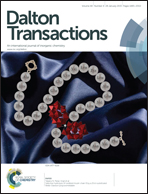Acridine based (S,N,S) pincer ligand: designing silver(i) complexes for the efficient activation of A3 (aldehyde, alkyne and amine) coupling†
Abstract
Complexes [AgL(NO3)CH3CN](1) and [AgLNO3] (2) were formed on reacting AgNO3 with L in acetonitrile for 12 h (at room temperature) and 24 h (at 90 °C), respectively, where L is a (S,N,S) pincer ligand, 4,5-bis(phenylthiomethyl)acridine, synthesized by the reaction of in situ generated PhS− with 4,5-bis(bromomethyl)acridine under N2 atmosphere. 1H and 13C{1H} NMR and the mass spectra of L and its two Ag-complexes were characterized. The structures of complexes 1 and 2 were established with single crystal X-ray crystallography. The Ag-S bond distances of complexes 1 and 2 are 2.5682 (11)/2.5017 (11) Å and 2.4894 (15)/2.4834 (15) Å, respectively. The ligand L in complex 2 is coordinated with the metal in a pincer mode and the complex has a pseudo-pyramidal geometry of donor atoms around the Ag. In 1, the metal is encapsulated by a ten-membered chelate ring. The two Ag(I) complexes were explored for the coupling of aldehyde, alkyne and amine (A3 reaction) and were found to be efficient as a 2.0 mol% loading of 1 and 0.5 mol% of 2 for good conversion. Complex 2 is a rare example of a catalyst that can efficiently activate A3 coupling at a 0.5 mol% loading of Ag.


 Please wait while we load your content...
Please wait while we load your content...